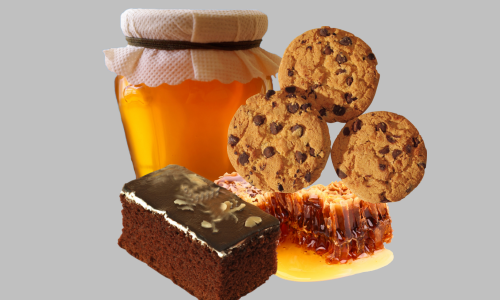
Sweet products are characterized by: sweet taste, attractive appearance, pleasant aromas and high carbohydrate content (glucose, fructose, sucrose) with a high energy value (4kcal for 1g).
Carbohydrates are great suppliers of energy in our diet, the amount provided by them varying between 50-55% of the energy received in a day. It is recommended that 65% of the carbohydrates consumed be polysaccharides (starch, glycogen, cellulose) and only 35% be low molecular weight carbohydrates (glucose, fructose, sucrose). Low molecular weight carbohydrates can cause glycemic peaks and diabetes while polysaccharides provide staggered energy over time. Of the low molecular weight carbohydrates, it is recommended that 20% come from natural sources (vegetables, fruits), and only 15% be refined sugar.
The sugary products used in our daily diet (sugar, starch, caramel products, jellies, chocolate and cocoa products, confectionery, honey, fruits and vegetables, etc.) can be analyzed by ICA R&D specialists to help you. ensure that your product intended for consumption is safe, checking its characteristics (organoleptic, physico-chemical, microbiological, etc.) in accordance with the legislation and regulations that it must comply with.
Analyzes for sweet products:
- Nutritional information: fatty acids (omega-3 and 6, monounsaturated, polyunsaturated, saturated, trans), calcium, fiber, phosphorus, Total carbohydrates / carbohydrates available, lipids, fats, fatty substances, magnesium, potassium, protein, sodium, energy value , total sugar, etc.
- Vitamins: B1, B2, B3, B6, B9, B12, A, C, E, etc.
- Organoleptics: aroma, appearance and shape, Consistency, color, taste, etc.
- General physico-chemical: pH, water, water activity, lactose, glucose, sucrose, maltose, acidity, starch, propionic acid, sorbic acid, benzoic acid, nitrogen (ammoniacal, nitric, easily hydrolyzable and total), nitrites, nitrates, dioxide of sulfur, caliber, cholesterol, milk fat, hydroxymethylfurfural (HMF), iodine index, refractive index, diastase index, proportion of components, ash (conductometric, insoluble in HCl and related to SU), cocoa butter equivalent, impurities , net mass, humidity, polarization, direct reducing sugar, dry matter, reducing substances (invert sugar), theobromine, sodium chloride, peroxide index, Kreis reaction, polycyclic aromatic hydrocarbons (PAH), etc.
- Metals and non-metals: aluminum, arsenic, cadmium, chromium, copper, iron, manganese, mercury, nickel, lead, selenium, tin, zinc, etc.
- Pesticides: pesticides (package 252 and 520 compounds), organochlorines (aldrin, total DDT, decachlor-biphenyl, dieldrin, endosulfan, endrin, heptachlor, methoxychlor, tetrachloro-m-xylene, α-chlordane).
- Mycotoxins: total aflatoxins, aflatoxin B1, ochratoxin A, deoxynivalenol, zearalenone, etc.
- Allergens: milk, egg, soy, and gliadin.
- Microbiological: bacillus cereus, sulfito-reducing anaerobic bacteria, coliform bacteria, yeasts and molds, enterobacteriaceae, escherichia coli, leuconostoc mesenteroides, listeria monocytogenes, total number of germs, salmonella, coagulase-positive staphylococcus, etc.
- Molecular biology: species analysis (detection of the presence of traces of meat in plant products), triple qualitative analysis of genetically modified organisms (35S promoter, NOS terminator, transEPSPS).
For more information, you can always contact an ICA R&D representative, to provide you with all the necessary information and guide you in choosing the set of analyzes you need so that we can then make you an offer of services appropriate to the situation and your product.
Our most common tests & services
Analysis, tests, audit, monitoring.
Analysis, tests, audit, monitoring.
Analysis, tests, audit, monitoring.
Analysis, tests, audit, monitoring.
All our tests & services
Analysis, tests, audit, monitoring.
Analysis, tests, audit, monitoring.
Analysis, tests, audit, monitoring.
Contact us for personalized research and develpoment services.
Specialized consultancy in terms of product quality and safety.
Specialized inspection and audit in the field of food production.
Training and development opportunities in a laboratory with modern equipment.
Scientific research and development center.
